Authentic Hungarian Goulash (Gulyás)
This post may contain affiliate links. See my disclosure policy.
A thoroughly authentic Hungarian Goulash recipe with a depth and richness of flavor that will satisfy both body and soul. Hungary’s national dish, this traditional gulyás captures everything that has made this dish so beloved across the globe. It is simply out-of-this-world delicious!
For more traditional Hungarian recipes be sure to also try my Chicken Paprikash, Bean Goulash, Pörkolt, and Szegedin Goulash!
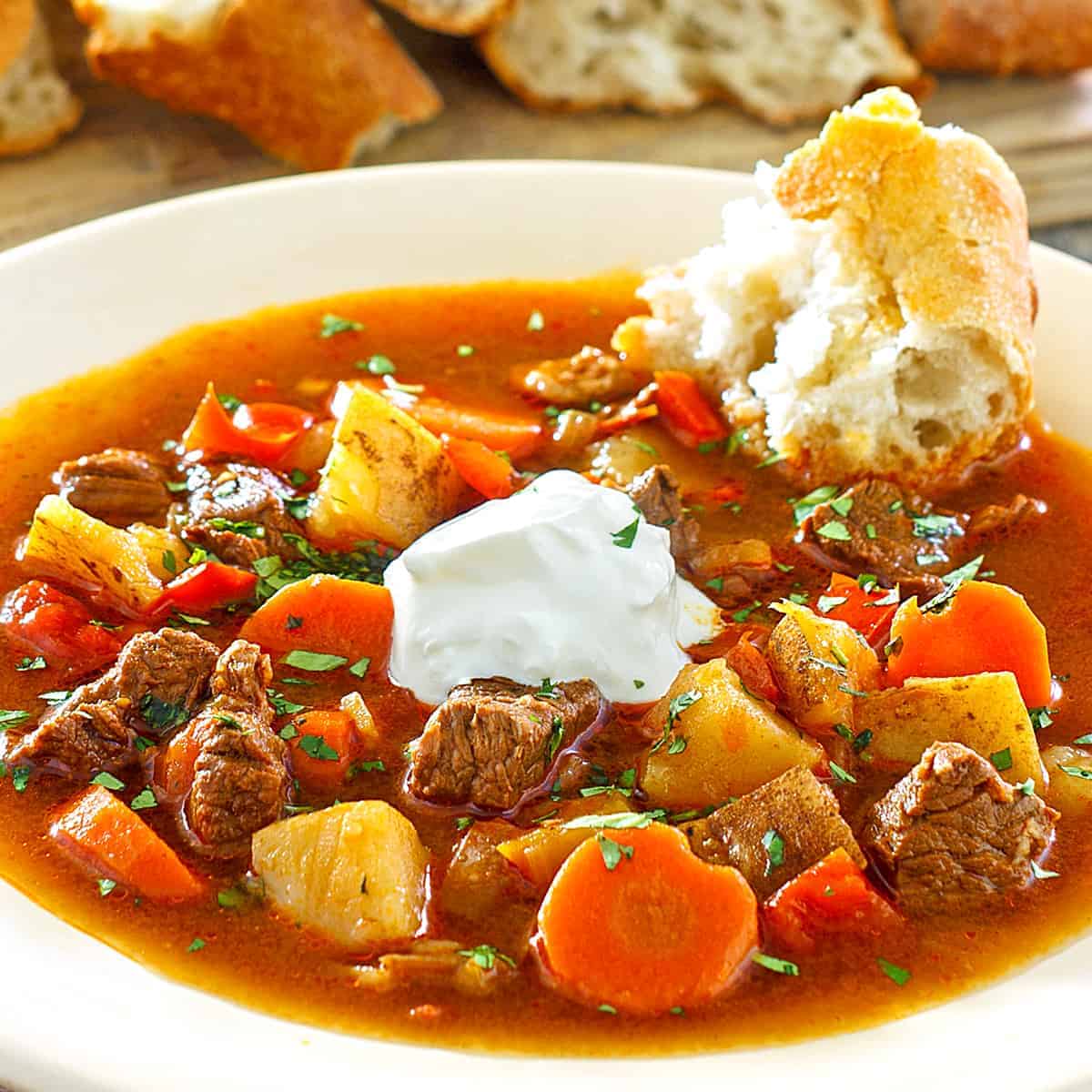
Traditional Hungarian goulash is a prime example of how a few simple ingredients, cooked properly, can yield an incredible flavor. Though many variations of Hungarian goulash exist, and every cook makes it just a bit differently, this is an authentic recipe from the heart of Hungary.
Hungary holds a special place in my heart and in my family’s hearts. My brother lived there for a couple of years and would always describe its beautiful scenery and architecture and his love for the Hungarian people. When I visited Budapest for the first time I immediately fell in love with it. Its name comes from the two sides of the city (Buda and Pest) separated by the Danube River running through it. With its striking chain bridge, stunning parliament building, and its incredible Buda Castle, Budapest is a breathtaking city.


Hungary’s history has been one of hardship and heartbreak. But the passion and stamina of soul has remained in the hearts of the Hungarian people. I’ve always been touched by Hungary’s national anthem, Himnusz, or “hymn”, written by the poet Kölcsey. Their anthem is a poetic prayer and unlike most anthems that focus on an expression of national pride, the Hungarian anthem is a direct, heartfelt plea to God. In the mid-20th century, during the years of strongest communist rule in Hungary, the words were not sung, only the music was played. The communist government asked two of the most acclaimed artists of that time, a poet and composer, to rewrite the national anthem. Both refused. The next communist leader also tried, unsuccessfully, to have it changed. And so Hungary’s national anthem remains Himnusz and its first three lines read:
O God, bless the nation of Hungary
With your grace and bounty
Extend over it your guarding arm

I also love Hungarian food. Their breads and smoked sausages are fantastic as are their meats, stews, sauces, and desserts. Today I’m going to share the national dish of Hungary: Goulash.
What is Hungarian Goulash?
Contrary to popular belief here in the U.S., Hungarian goulash is NOT made with ground beef or macaroni noodles! Traditional Hungarian goulash is an entirely different dish.
Goulash, or as Hungarians call it, gulyás, means “herdsman.” Its origins date back to the 9th century Magyar shepherds as a simple meat and onion stew prepared in heavy iron kettles known as bogracs. In the 15th century invading Ottoman Turks introduced a new spice to Hungary, paprika. While the rest of Europe remained lukewarm towards this red chili pepper from the New World, Hungary embraced it and paprika has since become a defining element of Hungarian cuisine.
Goulash is kind of in between a soup and a stew. Unlike some stews, Goulash is not overly packed full of beef and vegetables, it is a little more brothy. But through the cooking process, the broth becomes a little thicker and very rich in flavor.
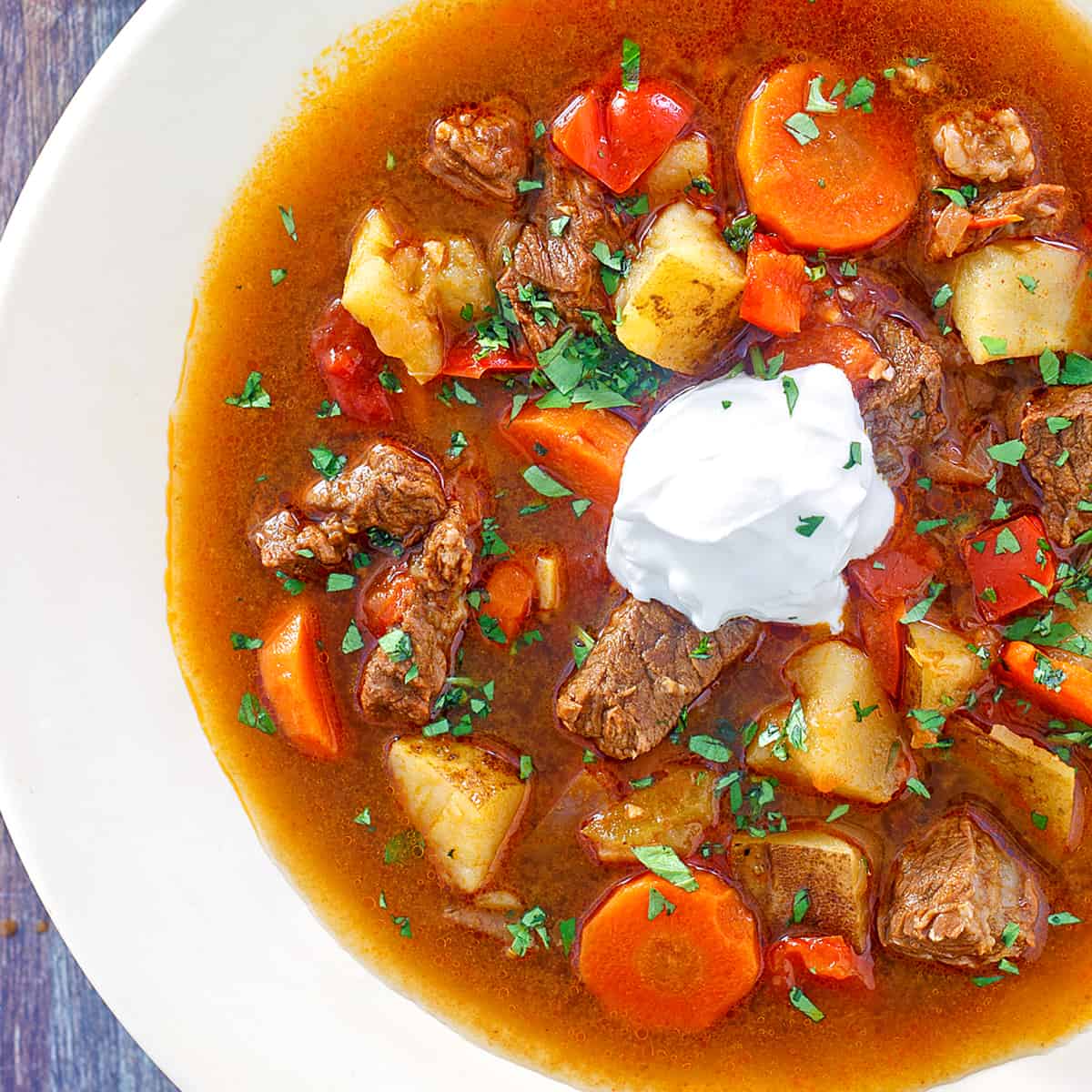
Tips for Authentic Hungarian Goulash
To achieve the ultimate flavor, the cooking method is important and quality, real Hungarian paprika is essential. And lots of it! None of this “2 teaspoons of paprika” jazz. Hungarians use very generous amounts of paprika, and that’s key. A Hungarian once told me, “however much paprika the recipe calls for – at least double or triple it!”
For this size batch of Goulash, you want to use a full 1/4 cup of it. When I lived in Germany, Hungary was just a few hours away and I would stock up on it when I visited. Now I order it online and recommend this genuine imported Hungarian paprika imported from Hungary. There is no comparison in flavor. It has an extraordinarily rich flavor and an exceptionally vibrant red color. Many of our readers have tried it and agree that quality Hungarian-imported paprika makes all the difference.
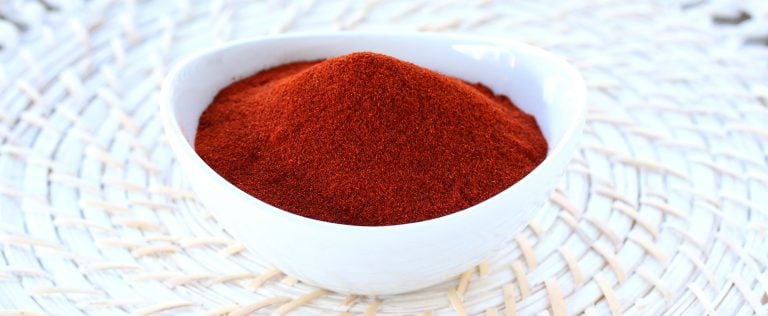
I mentioned earlier, many variations of goulash exist. Some include turnip or wine or caraway seeds, to name a few. But this recipe is a very old, very traditional way of making Goulash that my brother and I learned from older generations of Hungarian women and it needs no embellishments. It’s simple and simply delicious!
What’s the Best Dutch Oven to Use?
For this recipe, I recommend using a Dutch oven because it seals in the flavors and heats evenly, ensuring consistent cooking results. I love this 6-quart, budget-friendly option from Lodge, which you can get on Amazon for around $80. Or, if you’re looking for a worthy splurge, I also have this one from Le Creuset, which sells for around $300.
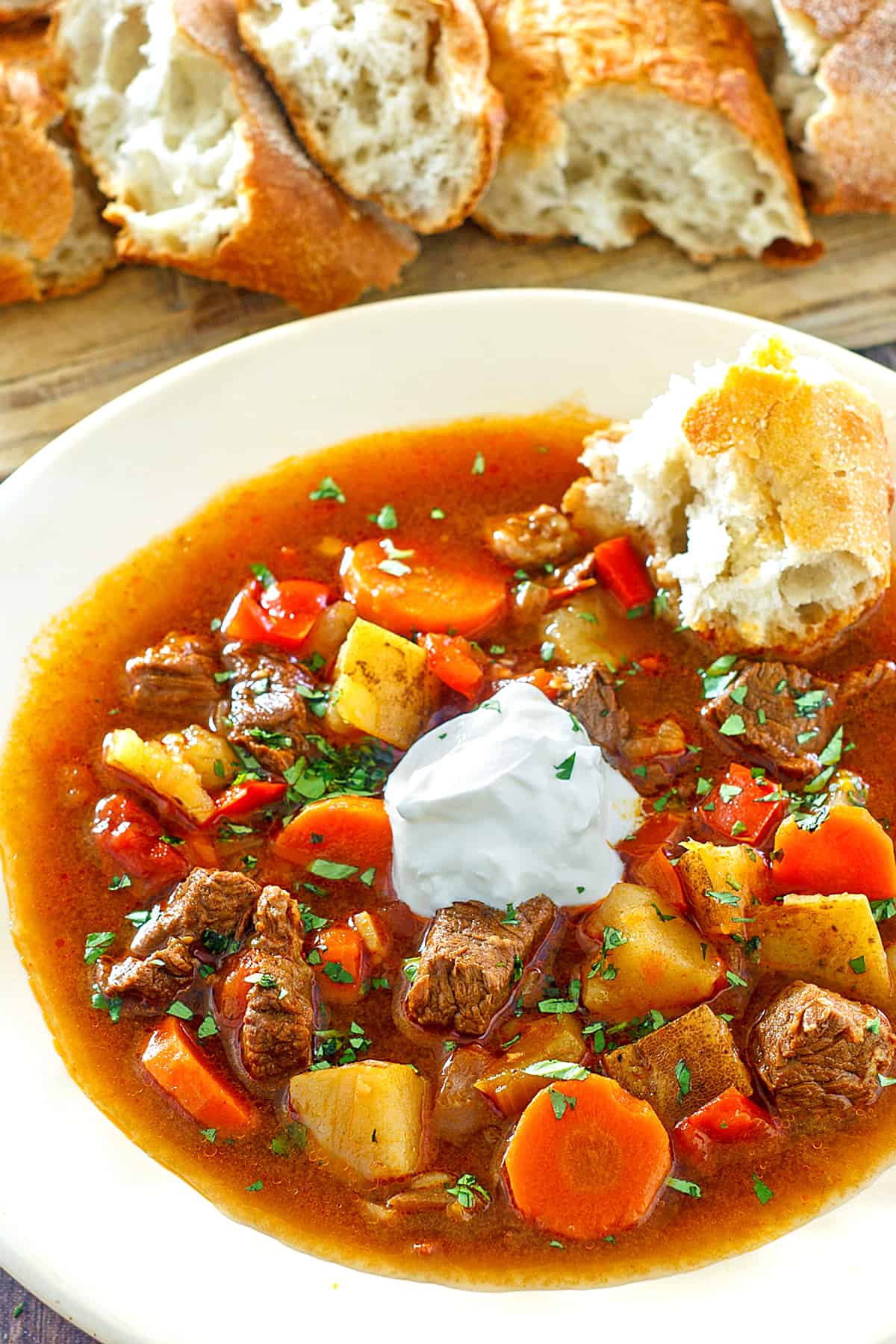
Hungarian Goulash Recipe
Let’s get started!
Melt the lard or butter/oil in a Dutch oven or other heavy soup pot over medium high heat and cook the onions until beginning to brown, about 7-10 minutes. Add the beef and cook until the beef is just starting to brown, 7-10 minutes.
Add the bell peppers, tomatoes, and garlic and cook for another 6-8 minutes. (Note about peppers: Outside of Hungary it’s very difficult to find the peppers they use there. The best ones to use in their place are red and some yellow/orange. Avoid regular green bell peppers as they have a starkly different flavor profile.)
Remove the pot from the heat and stir in the paprika, salt, pepper and caraway (if using) (note: paprika becomes bitter if at all scorched).
Add the beef broth, bay leaf, return to the stove and bring to a boil. Reduce the heat to medium, cover and simmer for 40 minutes. Add the carrots and potatoes. Return to a boil, reduce the heat to medium, cover, and simmer for another 30-40 minutes or until the beef is nice and tender. Add salt to taste. Remove the bay leaf.
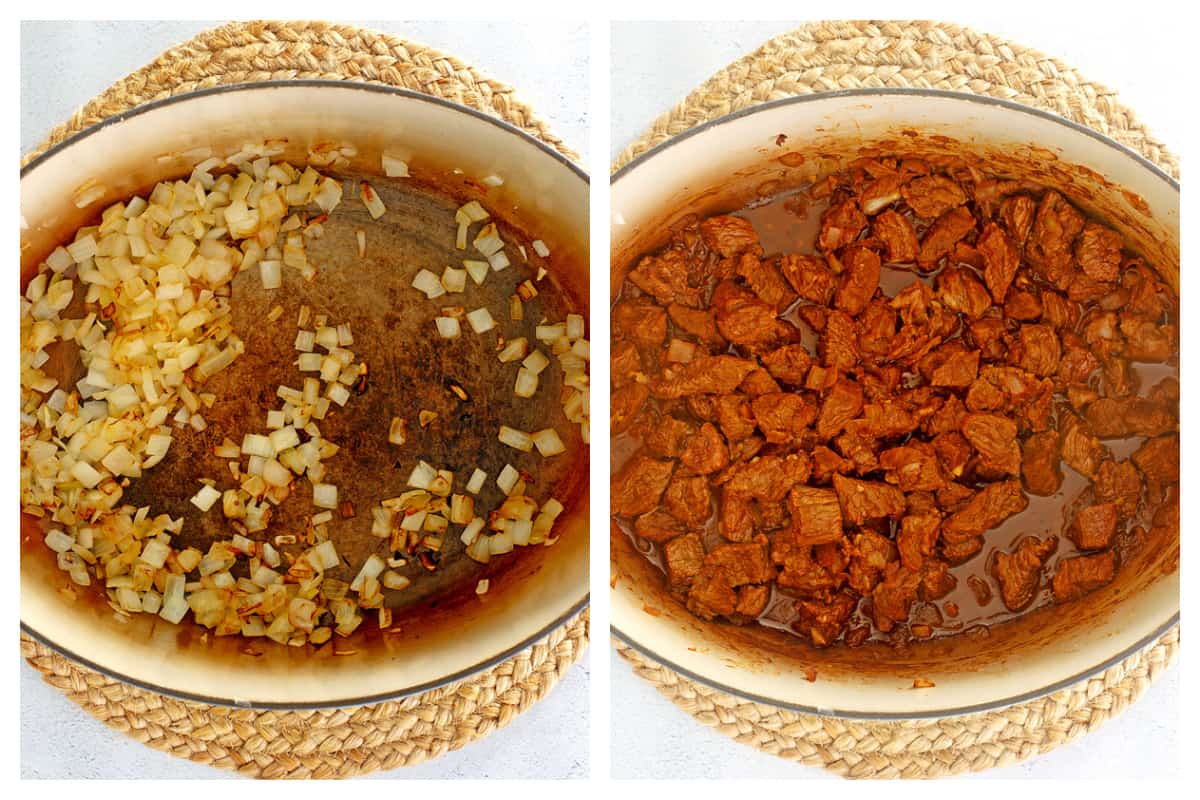
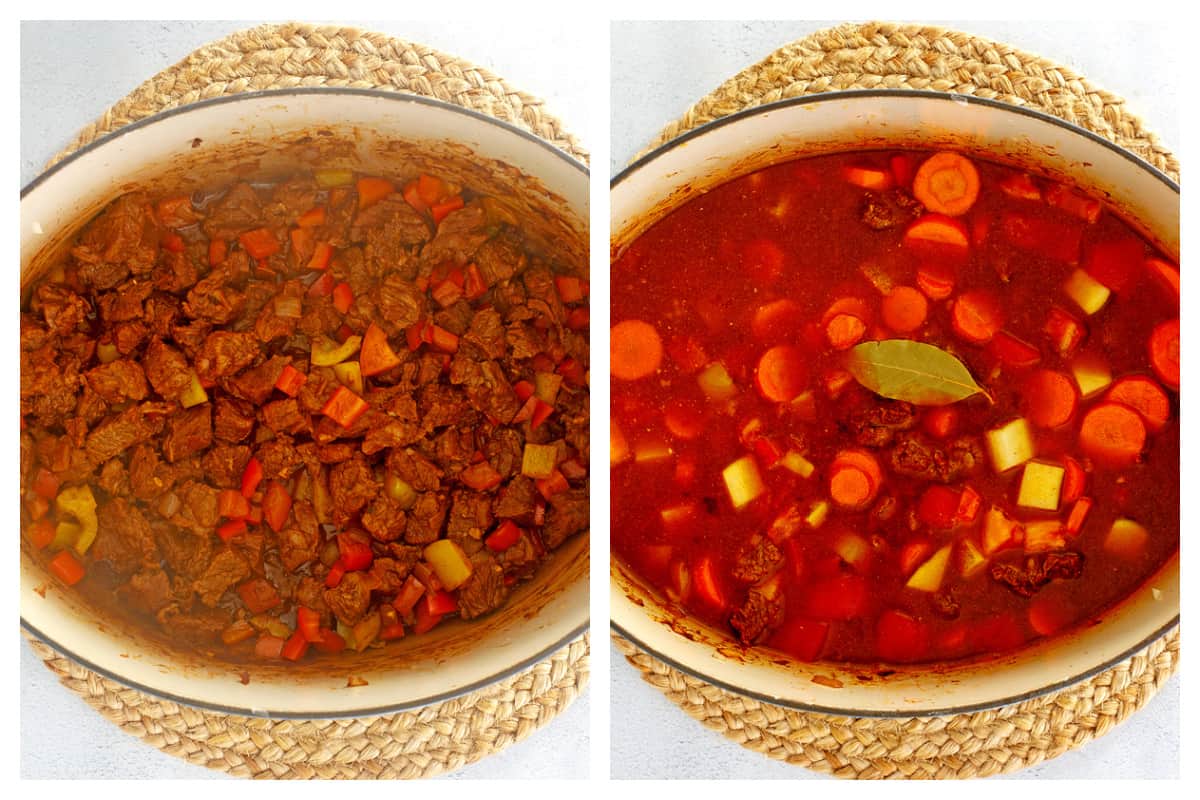
Serve with some crusty bread and, if desired, a dollop of sour cream.
Enjoy!
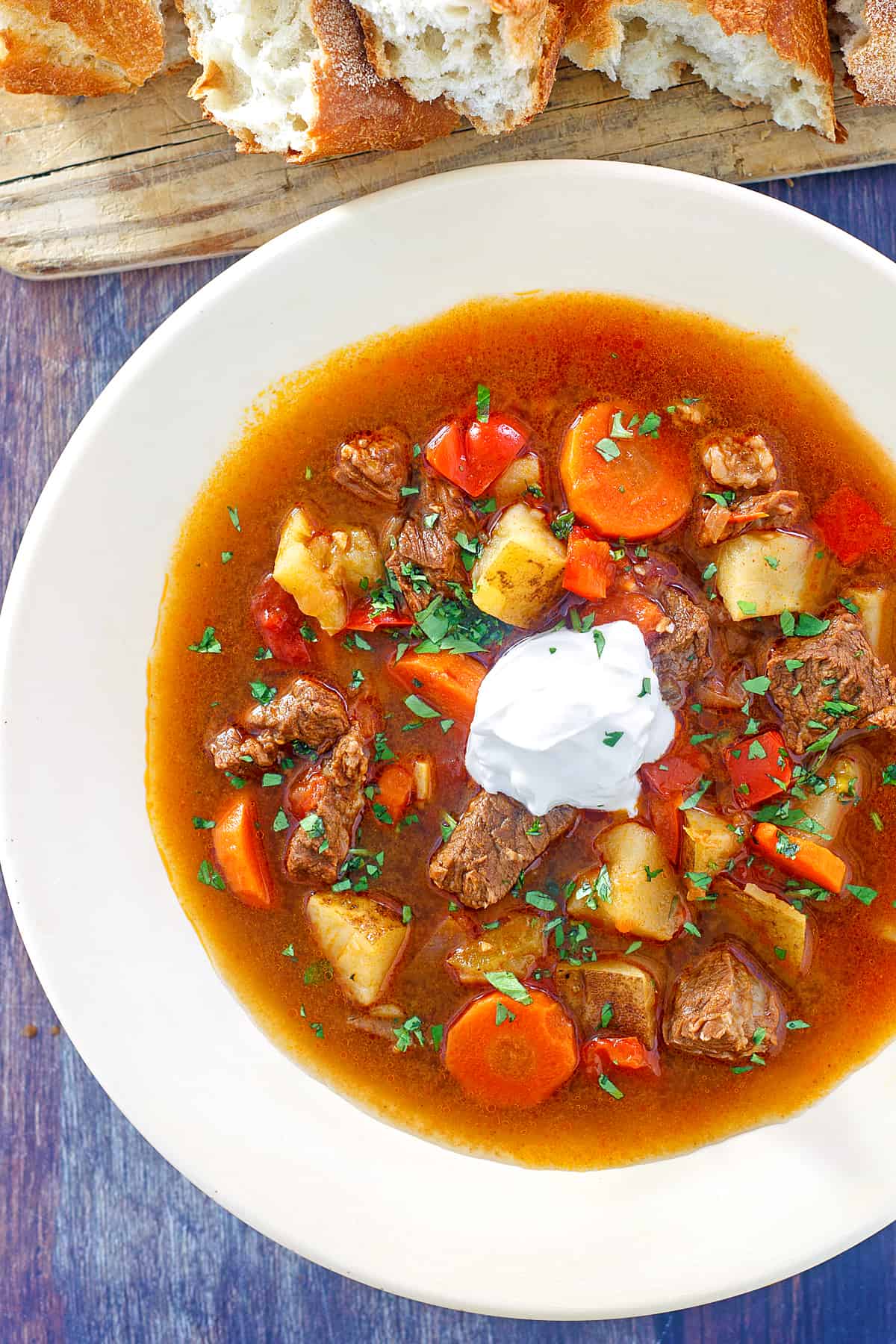
For more authentic Hungarian dishes, be sure to try my:
Save This Recipe
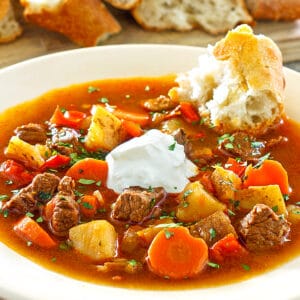
Authentic Hungarian Goulash (Gulyás)
Ingredients
- 3 tablespoons pork lard , or butter or bacon grease (pork lard is traditionally used and imparts a great flavor)
- 1 1/2 pounds yellow onions chopped
- 1/4 cup quality genuine imported Hungarian sweet paprika
- 1 1/2 pounds stewing beef , cut into 1/2 inch pieces
- 5 cloves garlic ,minced
- 2 red bell peppers ,seeded/membranes removed, cut into 1/2 inch chunks
- 1 yellow bell pepper ,seeded/membranes removed, cut into 1/2 inch chunks
- 2 tomatoes ,diced
- 2 carrots ,diced
- 2 medium potatoes ,cut into 1/2 inch chunks
- 5 cups beef broth (traditionally just water is used but beef broth adds so much more flavor)
- 1 bay leaf
- 1 teaspoon salt
- 1/2 teaspoon freshly ground black pepper
- 1/2 teaspoon crushed caraway seeds (optional, not traditional in all regions)
Instructions
- Melt the pork lard or butter/oil in a Dutch oven or other heavy soup pot over medium high heat and cook the onions until beginning to brown, about 7-10 minutes. Add the beef and cook until the beef is just starting to brown, 7-10 minutes. Add the bell peppers, tomatoes, and garlic and cook for another 6-8 minutes. Remove the pot from the heat and stir in the paprika, salt, pepper and caraway (if using) (note: paprika becomes bitter if at all scorched). Add the beef broth, bay leaf, return to the stove and bring to a boil. Reduce the heat to medium, cover and simmer for 40 minutes. Add the carrots and potatoes. Return to a boil, reduce the heat to medium, cover, and simmer for another 30-40 minutes or until the beef is nice and tender. Add salt to taste. Remove the bay leaf.
Nutrition
Originally published on The Daring Gourmet on March 18, 2014
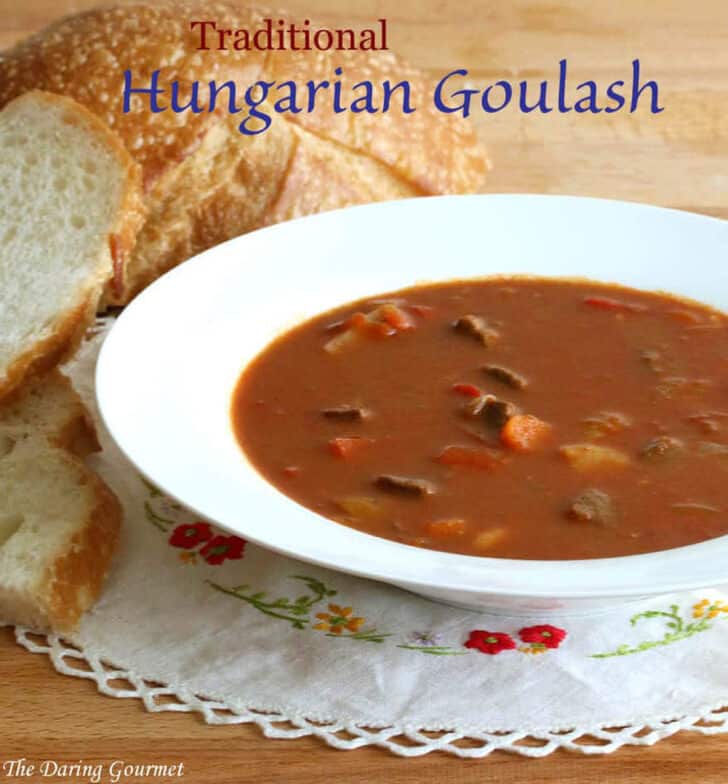



















Could I use parsnips instead of potatoes? I know potatoes are traditional, but I want to make this for Chanukah with a side of potato lakes and that seems like too much potato.
That sounds like a good substitute, Andrea. Happy cooking!
I am very found of using parsnips as my mother used both parsnips and potatoes.
This is a wonderful recipe – my family LOVES it!!
Thanks so much, Lisette!
Hi Kimberly, I remember Hungarian from my childhood, eating it with great relish! What can I replace the lard with? Not butter or any dairy (kosher kid here). Olive oil doesn’t seem to be compatible, nor sesame or peanut oil. Would coconut oil or a nut butter like almond be suitable?
Hi Michelle, I would go with something neutral tasting – peanut oil, canola oil, avocado oil. For frying I use avocado oil the most because it’s a healthy oil and has the highest smoke point. But peanut and canola are also neutral tasting. Happy cooking!
Hi Michelle,
Just in case you are still following, Sunflower Oil is one of the most common substitute for Lard in the North East corner of Hungary (Monok, Szerencs, Tokay), I was born there almost 70 years ago. I have just served 18 of my best Friends a Bogracs full of Gulyas where I used Duck Fat (in the Past Smaltz as my Fat) and they all were delicious. There are a couple of regional veggies that we add to the dish for our changing group of Dinners who join us periodically at our place in the Country. In case you are interested, let me know and I can share with you. Give it a go and let us know how it all turned out. Good eats my Friend.
Made this recipe in the summer of 2015 , in part, because I had a trip to Europe planned for October which included a stop in Budapest. The recipe was delicious and as I sat here in our recent snowfall it struck me that it would be perfect for the season. I am following the recipe quite closely and I am not new to the kitchen, but I notice your asessment of prep time as ten minutes and I laugh. I would be fascinated to watch you clean and dice all of those veg’s and the meat in ten minutes.
Aside from that, I enjoyed my brief time in Budapest , though getting there was an adventure in the midst of the first surge of the ongoing immigrant crisis.
I’m glad you enjoyed this, Bill, thank you. I guess I probably am something of a Speedy Gonzales in the kitchen – it’s makes my husband nervous sometimes ;)
This recipe is great. I used it twice already and the result is beyond yummy.
Thanks for posting this!
Terrific, Andrea, thanks so much!
Thanks Kimberly. Just back from Eastern Europe and had tasted some of the gorgeous Hungarian gulyash. Tasted goulash in England before not quite the same though. Budapest and Bratislava offered some fantastic gulyash. I am going to try your recipe. Thank you for sharing. Kevin from Malaysia.
Hi Kevin, greetings to Malaysia! That’s fantastic, yes please let us know what you think once you’ve had the chance to try this. The leftovers are even better the next day!
Hey! Thanks for the amazing recipe. I was one of those who grew up with the elbow macaroni goulash. But studying abroad in Prague and traveling around central europe, I was exposed to the good stuff. It’s incredible what that sauteing of the onions beef garlic and paprika does to the flavor. I was also amazed at how the broth thickens to that perfect consistency (between a soup and a stew). Thanks again!
Thanks, Tori, I’m so glad you enjoyed it! It’s so true how big a difference methodology makes in cooking, some steps just can’t be skipped if you want to achieve the best results. Thanks again!
Argghhh! Looking for the Hungarian Beef Goulash recipe in a ’70s or ’60s Good Housekeeping Cookbook. As I recall: 2 lbs [good] beef stew meat, 2 lbs onions (cut in rings). Melt four tbs butter in stew pot. Add and cook onions until golden brown. Add meat, teaspoon salt……and 1/4 cup paprika (I add more…and the hot variety). Cover and cook [trying to remember] one hour(?) to 1&1/2 hours(????) on low heat. Off heat, mix in 8oz. sour cream. Serve over bowtie pasta
Nice thick sauce……
Anyone know if my recollection is correct
Any recipe with other vegetables…or less paprika….ugh. You want vegetables, make beef bourguignon.
Hi Rick. Good Housekeeping, however good their intentions, failed dismally at publishing a real Hungarian goulash. Authentic Hungarian goulash includes bell peppers, tomatoes, carrots and potatoes.